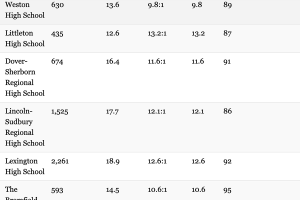Massachusetts Test Scores Top Nation’s School Districts Again
Fourth- and eight-graders in the Bay State outperformed their peers on the National Assessment of Educational Progress exams in 2017.

Photo via iStock.com/billnoll
It may supposedly be lonely at the top, but we’d say the view is just fine from up here.
The latest results from the National Assessment of Educational Progress exams were released on Tuesday, and once again, Massachusetts leads the pack. NAEP, also known as the Nation’s Report Card, reflects the math and reading scores of fourth- and eighth-grade students in districts across the country.
And in 2017, 53 percent of fourth-graders and 50 percent of eighth-graders in the Bay Stay earned proficient or better scores in math, while 51 percent of fourth-graders and 49 percent of eighth-graders did so in reading. Nationwide, 40 percent of fourth-graders and 34 percent of eighth-graders were proficient or better in math; and 37 percent of fourth-graders and 36 percent of eighth-graders reached the mark in reading.
Though Massachusetts landed on top, these results probably don’t have education officials popping champagne. Yes, Bay State students outperformed the nation as a whole, but they didn’t exactly outperform their own predecessors. Eighth-grade reading scores improved here by a statistically significant margin, but scores in fourth-grade math and reading, and eighth-grade math, did not. The stagnation matches a general lack of growth reflected in schools across the country by NAEP.
And in addition to slow growth, achievement gaps also continue to plague America’s school districts. The new NAEP data indicates 64 percent of Massachusetts fourth-graders who are Asian earned proficient or better marks in math, and 60 percent of their white peers did, too. Meanwhile, 29 percent of black and Latino fourth-graders scored proficient or better on the fourth-grade math test, according to the Boston Globe.
On top of the state-level data, NAEP broke down the scores of school districts in the nation’s largest cities. Boston Public Schools’ eighth-graders distinguished themselves in both math and reading, outperforming their peers in all but three large districts in math and four large districts in reading.
But BPS fourth-graders didn’t speed past the national averages to the same extent and roughly matched the mean scores of students in similar districts across the country. Twenty-nine percent of BPS fourth-graders reached proficiency or better in reading, which is one percentage point higher than the average. And in math, the 31 percent of BPS fourth-graders who reached proficiency matched the average across large districts.
BPS Superintendent Tommy Chang said that though the NAEP results show some positive growth, there’s still a long way to go in helping all students thrive at school.
“We have a lot of good news to celebrate with the results of these scores,” Chang said in a statement. “At the same time, there is much work to be done to close the opportunity and achievement gaps. BPS will work tireless to ensure that all students have an equal opportunity to succeed in college, career, and life.”

